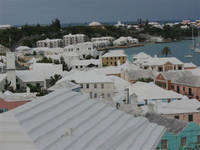May 9, 2005
Coral shelters. Monday, May 9th, 2005

The coral reef surrounding Bermuda acts as a protective circle to the island and its inhabitants. First, in a physical manner, sheltering the island from storms, as this ecosystem acts as a barrier where waves break off. “In fact, the most superficial corals are the most damaged after a hurricane”, Ricardo confirms. Clothed by this impressive and beautiful natural barrier-also a source of life and food-the people of Bermuda take shelter under a second protective layer: their coral houses.
As we approached the island, apart from observing the undulating aspect of the landscape-because of its rolling hills-we noticed immense white spots that were scattered around the island. It could not be snow; we thought it could be some type limestone…Now we know the reason for that color: all houses in Bermuda have the same kind of stepped roof, of an intense white color. It could have been lime, like that covering the walls of houses in the Spanish south, but this is actually coral. We learned this from Cubbit Smith, a Bermuda resident whose ancestors from this island go back more than 300 years. He says it with pride and, it also appears in his presentation card.

“All Bermuda residents are forced by regulation to coat the roofs of their houses with coral plates, because this is a highly poriferous material, and this is how they get the water they needd to wash dishes, cook and bathe. Water from rain is gathered in containers, and passed through several purifying filters” explains Cubbit, farmer and occasional taxi driver. Ricardo brings to our attention the fact that, like the people of Bermuda, Polinesians also use the same material to cover their homes.
In the particular case of Bermuda, the connexion between corals and survival of its people is beyond obvious. “The coral reef is a guarantee of life for us, because it protects us. It also acts as a kind of “nursery” for juveniles of commercial species, so it is a food source. It is also a source of water; without it, we could not sustain a stable population of 70.000 people, apart from tourists”, Cubbit continues explaining. We have seen our occasional guide, enthusiastic of the flora and fauna of his island, walking around while we visited the mangrove swamp area. After a lively conversation, he offered to take us back to Saint George and on our way back to the Ranger, we ponder on the important role coral reefs play in sustaining life in the oceans.

